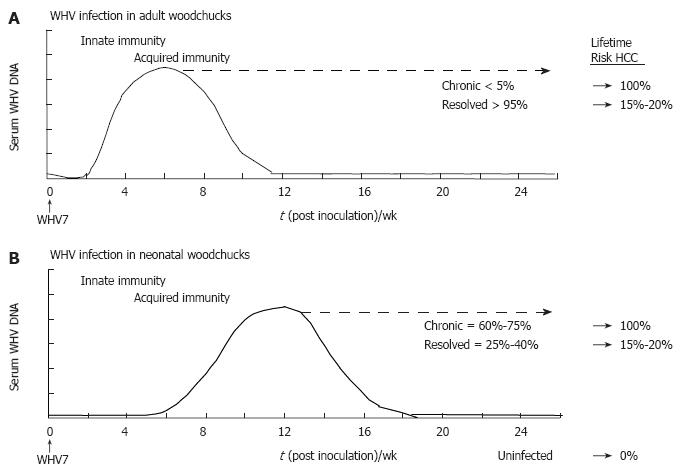Copyright
©2007 Baishideng Publishing Group Co.
World J Gastroenterol. Jan 7, 2007; 13(1): 104-124
Published online Jan 7, 2007. doi: 10.3748/wjg.v13.i1.104
Published online Jan 7, 2007. doi: 10.3748/wjg.v13.i1.104
Figure 2 Schematic profiles for serum viremia in adult and neonatal models of experimental WHV infection.
A: Adult woodchucks. Adult woodchucks born to WHV-negative dams are infected with 1 x 107 woodchuck infectious doses 50% of a defined WHV inoculum by the intravenous route. The proportions of chronic and resolved outcomes of adult woodchucks usually are less than 5% and more than 95%, respectively. The lifetime risk for the development of HCC in established chronic and resolved WHV infections is 100% and 15%-20%, respectively; B: Neonatal woodchucks. Neonatal woodchucks born to WHV-negative dams are infected with 5 x 106 woodchuck infectious doses 50% of a defined WHV inoculum by the subcutaneous route. The proportions of chronic and resolved outcomes range between 60%-75% and 25%-40%, respectively. The lifetime risk for the development of HCC in established chronic and resolved WHV infections is 100% and 15%-20%, respectively. HCC in uninfected, WHV-negative woodchucks is not observed. Approximate time intervals for the development of innate and acquired immunity are shown.
- Citation: Menne S, Cote PJ. The woodchuck as an animal model for pathogenesis and therapy of chronic hepatitis B virus infection. World J Gastroenterol 2007; 13(1): 104-124
- URL: https://www.wjgnet.com/1007-9327/full/v13/i1/104.htm
- DOI: https://dx.doi.org/10.3748/wjg.v13.i1.104









